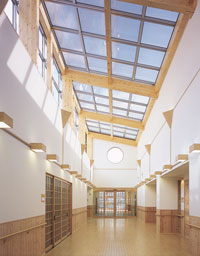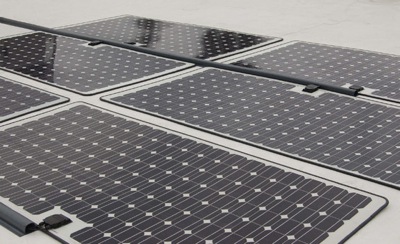Newsweek has an interview with William McDonough, Q&A: The Future of Green Buildings | Newsweek Future Of Energy | Newsweek.com, which focuses on his ideas about the green building movement and the direction architecture is taking. For those versed in Green Architecture, there really is nothing new in this article, but for the general public this can serve as a nice introduction to some of the standard green concepts such as “cradle to cradle design”, densification, green roofs and renewable energy.
Tag: Green Architecture
Solar Glass

[Image via Suntech]
So I was going through last month’s Architecture Record and as an unlicensed architect working in building production (not design) I tend to spend more time and effort looking at the products advertised instead of the featured buildings. One of the products that jumped out at me is Suntech’s See Thru photovoltaic vision glazing. This product utilizes insulated glazing technology to apply a thin photovoltaic film on the interior surface of a glazing panel and can turn “clear” glass into a solar array. Some examples of this in action can bee seen here.
If this product was used in addition to the thin film roof membrane I previously mentioned here, I think that many more structures – residential and commercial – could easily be turned into parts of a large scale distributed power generator. In addition, achieving the LEED point for on site energy creation would be much easier to achieve without having to design a building with all flat roofs and solar arrays. The new Green Architecture Symbol may very well be glass. Think of it, the International Style might actually be suitable as an international style; the Farnesworth House could be an icon of self sustainability instead of a symbol of architectural ego triumphing over nature and place.
Urban Parkland
So I’ve been digging through the archive of articles that I have meant to write about, but have not had the chance and came across this article from boston.com which discusses Green Roofs, specifically the the American Society of Landscape Architects (ASLA) in Washington DC, and discusses their popularity in Europe and compares them to standard roofs.
Green roofs are one of the areas where building design in the US lags behind the rest of the developed world. In Europe, green roofs are more ingrained in the culture, for lack of space and in the northern climates, as a pre-modern cultural adaption. It has only been recently that this urban parkland has been identified as a environmental boon, and not just a social one. In the US contractors balk at putting dirt, substrate, plants and a drainage method on a roof, complaining that ti will be too costly, need more structural reinforcement that the design calls for, and pose greater chances for leaks. Yet rooftop gardens have been a fixture in NY for years and not just in skyscrapers.
But green roofs should not just be urban elements. The suburban strip mall is perfect for green roofs or PV panels. The large expanses of asphalt and the traditional tar flat roofs can create suburban heat islands to rival their urban counterparts. Plus, it would be a good marketing ploy. Imagine if Target decided that to show its environmental awareness they would plant a green roof on every store, and whatever rainwater seeps through the soil, will be collected in a brown water storage system and used to flush toilets and urinals. Not only would they reap the benefits of lower heating/cooling loads and less municipal water use, but they would also bring in many customers looking for an “environmentally friendly” shopping experience.
Solar Stickers – Now by LISA FRANK!

[Image via DRI Energy]
So I have been studying for my LEED AP exam lately, so my interest was peaked when I came across this article online. Apparently, DRI Energy has come out with a product called Lumeta PowerPly which adheres directly to the roofing membrane instead of being mounted on an expensive and heavy roof structure, which is one of the prohibitive cost factors in the implementation Photovoltaic Panels. I imagine that this application will have less of a yield because it is fixed to the angle of the roof than rack mounted systems, which can be tuned to face an optimal angle or even rotate and tilt to follow the sun.What is lost in yield I imagine can be made up on roofs that would normally not be able to handle PV panels (such as curved roofs and steep pitches). In addition, I would worry that since this bonds to the roofing membrane, if there is a membrane failure the PV panels will need to be replaced as well, instead of being able to be removed and remounted in a traditional system.
I knew that this technology was out there, but I was unaware that it was already being marketed. I think that this kind of application process could definitely help bring PV panels and solar energy use to projects that would normally not even consider it.
(And in case anyone is wonder, no they aren’t in rainbow colors and are not actually made by Lisa Frank)
Organic Planning?
Recently I have made a number of posts regarding green buildings and the paradigm shift which will be necessary if we are even going to have a truly green architecture (see posts here and here). I bring this up again because i recently read two different articles online from two different architectural professionals from two different cultures, Martha Schwartz – a Boston & London based landscape architect and Harald Bodenschatz – a professor of Sociology and Planning in at the Technical University of Berlin and they both discuss similar goals for a more environmentally friendly development. Schwartz focuses on the urban landscape and its development (or lack thereof) currently as opposed to in a truly green environment, and Bodenscahtz focuses on the development of inner cities and suburbia as sustainable growth tactics and in such a way to help the European city thrive.
While neither of these articles explicitly states my previously argued hypothesis (that in order to be a truly sustainably designed society we need to increase our population densities and thus maximize our transportation schemes), both provide intellectual support to my arguments. Without a new 21st century version of urban renewal – one which is culturally, environmentally and economically sensitive – we will never be able to sustain our growth and development. This collapse in infrastructure is one of the issues facing us today, and it is potentially more threatening than global warming, rising oceans, and food shortages. With more people in the suburbs there are more cars on the road, the more cars the more wear on the roads. The more cars, the higher the demand for and thus the higher the price of gasoline, and the higher the demand for gas the less money available for other “necessities.” Greatly improved mass transit systems could alleviate the strain on our fuel supply and roads, while slightly increased mass transit systems but planned suburban clumping and urban densification could easily have the same impact.